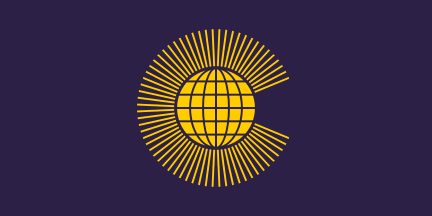 by Dean Thomas, 31 March 2004
by Dean Thomas, 31 March 2004 
Last modified: 2006-12-30 by rob raeside
Keywords: british empire | commonwealth of nations | commonwealth games | international organization |
Links: FOTW homepage |
search |
disclaimer and copyright |
write us |
mirrors
See also:
The Commonwealth Secretariat web site includes some interesting information on the history of their flag, which it dates to 1973 but, as often understandably seems to be the case with official sources, there is no earlier symbol or flag for comparison purposes:
The Commonwealth symbol was originally designed by the Gemini News Service, London in 1972 and approved by the first Commonwealth Secretary-General, Mr Arnold Smith C.H.In 1989 a second logo was introduced to appear on official Commonwealth Secretariat publications, and in 1999 a special commemorative logo was produced to mark the 50th Anniversary of the modern Commonwealth.
In 2000 the current Secretary-General Rt. Hon Don McKinnon, approved a new design that is now in use in place of the original designs. This design incorporates the image of the globe used in the original logo and the spears that make up the letter "C" from the 1989 design.
The radiating spears do not represent the number of countries in the Commonwealth but symbolise the many facets of Commonwealth cooperation around the world. The symbol is used on all official documentation and, sometimes in association with other specially developed logos, for the documents and logos of all Commonwealth Meetings. There is no fixed size or colour for the symbol but because of its frequent appearance on Commonwealth documentation, the black on white and gold on blue versions are commonly used.
The Commonwealth Flag consists of the Commonwealth symbol in gold on a blue background centred on a rectangle.
The flag developed from the car pennants produced for the first time at the Ottawa Commonwealth Heads of Government Meeting in 1973.
It is flown at Marlborough House, London, the headquarters of the Commonwealth Secretariat, throughout the year and for a limited period at other venues where Commonwealth Meetings are held or when other Commonwealth events/ visits are taking place for example Commonwealth Heads of Government Meetings.
The flag shown on the Commonwealth Secretariat web site uses a lighter blue and spindle-shaped spears.
Colin Dobson, 14 July 2005
The members, on 1 December 1996, were: Antigua and Barbuda,
Australia, the Bahamas, Bangladesh, Barbados, Belize, Botswana, Brunei, Cameroon, Canada, Cyprus, Dominica, Fiji (suspended), the Gambia, Ghana, Grenada, Guyana, India, Jamaica, Kenya, Kiribati, Lesotho, Malawi, Malaysia, Maldives, Malta, Mauritius, Mozambique, Namibia, Nauru (special member),
New Zealand, Nigeria,
Pakistan, Papua New Guinea, St.Kitts and Nevis, St.Lucia, St.Vincent, Samoa, Seychelles, Sierra Leone, Singapore, Solomon Islands, South Africa, Sri Lanka, Swaziland, Tanzania, Tonga, Trinidad and Tobago, Tuvalu, Uganda, United Kingdom,
Vanuatu, Zambia, Zimbabwe (suspended).
based on
http://www.thecommonwealth.org/Internal/142227/members/, 28 December 2006
The Commonwealth describes itself as an
association of states that have experienced direct or indirect British rule or
have been otherwise administratively linked to another Commonwealth country,
with the exception of Mozambique which was admitted in recognition of its
contribution to the struggle against apartheid in South Africa.
Jonathan Makepeace, 27 April 2005
The Commonwealth of Nations is listed on the Guinness Book of Records as the World's largest political alliance.
The Commonwealth of Nations is an evolving entity from the old British Empire. While some regard the Commonwealth as an anachronism, the ties to "the old country" has kept the movement going, as shown by the Commonwealth Games, which are held every four years. Mozambique was the first non-former-British Empire nation admitted to the alliance in the last decade of the 20th century.
At 15:21 21/04/2003 -0000, J. Patrick Fischer wrote: In flags@yahoogroups.com,
Nathan Lamm wrote: Are there any other members of the Commonwealth that were
not British colonies at some point? On the other hand, what nations that
were British colonies are not? I can think of the US, Ireland, and Arab nations
(and mandates like Israel), as well as pre-modern period possesions in France,
Central America, and so on.
Santiago Dotor replied: Namibia (1884-1920: German Protectorat, 1920-1990:
South African Protectorat).
Sorry for the rather NFR nitpicking but am I wrong in believing that South
West Africa (SWA) was a League of Nations, later UN, *mandate* (not quite
the same as a protectorate) from 1920 to 1966, and after that an occupied
territory?
Dean Thomas replied: South Africa wanted to incorporate SWA into it's territory after World War 2, but the United Nations did not want this to happen. South Africa did not want SWA placed under the UN trusteeship system so it said that the territory would continue to be administered under the original League of Nations Mandate. The UN declared an end to the mandate in 1966 - which south Africa ignored until 1990.
At 17:27 21/04/2003 +0100, Jorge Candeias wrote: Part of Cameroon,
too, was never under british control.
Santiago Dotor replied: I believe that actually all of nowadays Cameroon
was under British control, although only part of the German protectorate
of Cameroon(s) became British Cameroon -- the rest going to French Central
Africa (Ubangi-Chari) and Gabon. See Joaquín de Salas excellent map
of colonial Africa 1912: http://www.terra.es/personal7/jqvaraderey/191206af.gif.
Dean Thomas, 31 March 2004